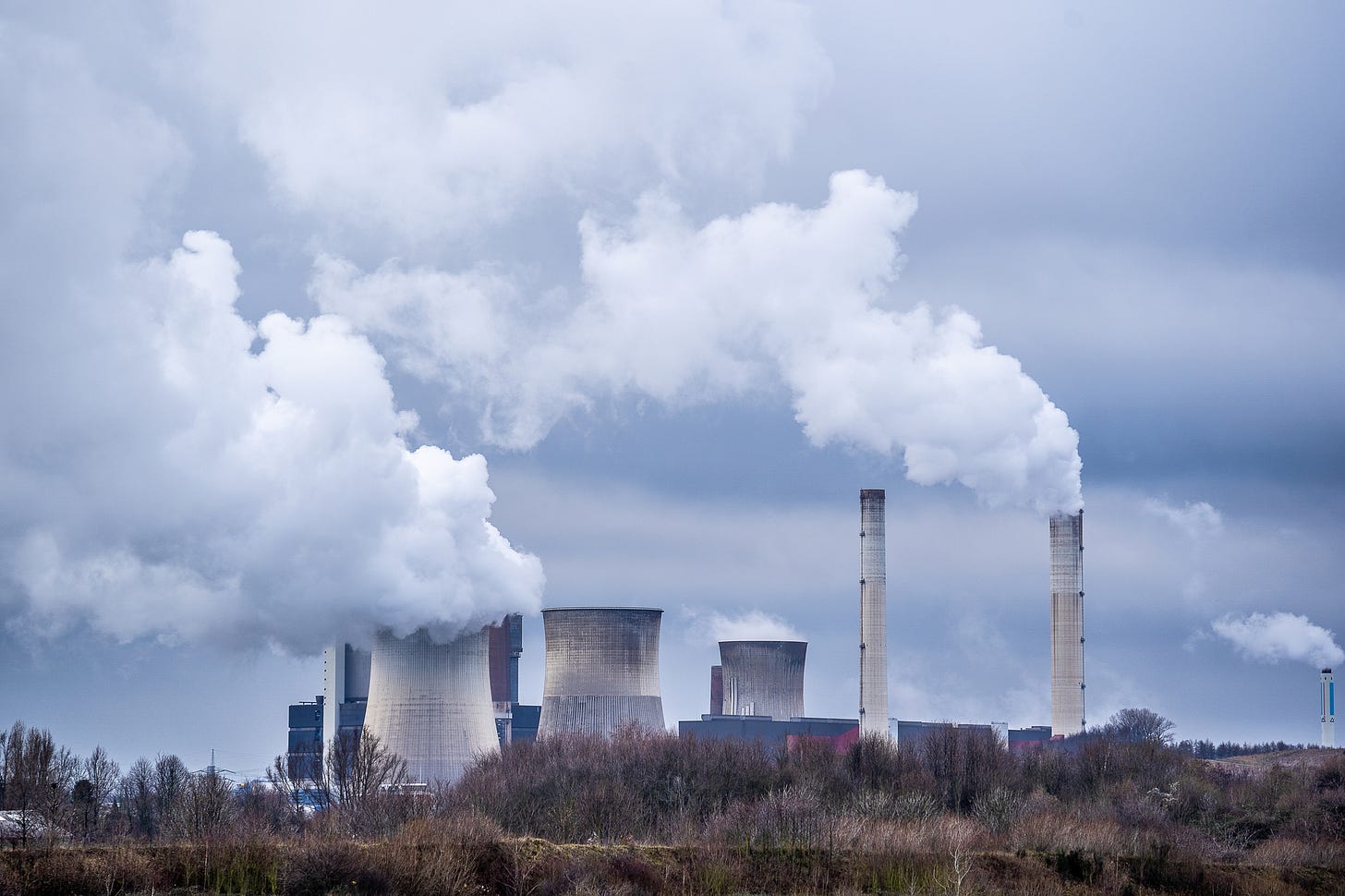I Liked The Idea Of Carbon Offsets, Until I Tried To Explain It
Avoided emissions seem like a (well-intentioned?) shell game
To quote from a 2020 Vox article:
Amazon. JetBlue. Delta Airlines. Elton John. Dave Matthews Band. Justin Trudeau. Austin, Texas. Norway. Nestlé. The Tokyo 2020 Olympics. NASCAR.
This odd mélange of companies, celebrities, cities, countries, and organizations have all made commitments to curb their contributions to climate change, if not eliminate them entirely. And they have one tactic in common: buying carbon offsets.
The idea behind offsets is simple: instead of halting your own carbon emissions, you pay someone else to reduce theirs. It’s attractive because the net reduction in CO2 is the same, but the cost can be much lower, meaning we can achieve faster reductions and/or minimize the impact on the economy. For instance, today there is no practical way for an airline to stop burning jet fuel, but JetBlue has been offsetting their emissions by helping to fund programs such as solar and wind farms, forest protection, and landfill gas capture1.
It’s a controversial topic. Some claimed “offsets” are fairly sketchy. It’s been argued that all offsets are a smoke screen that allows polluters to keep on polluting. Personally, until I sat down to write this piece, I felt that offsets were useful when evaluated rigorously. But it took me three or four tries to write a complete draft. Each time, I would get halfway through, only to realize that my concept of when offsets make sense was flawed. It’s just too difficult to frame a coherent story in which offsets help us on the path to net zero emissions.
In the end, I’ve come around to the view that most offset programs do not get us closer to a net zero world, and therefore are a dangerous distraction. There are some very well-intentioned and well-run organizations engaged in tracking and certifying offsets, but unfortunately I think they’re relying on a flawed premise.
Negative Emissions vs. Avoided Emissions
Offsets come in two flavors:
Avoided emissions are when you induce someone not to emit some carbon that they otherwise would have emitted. For instance, you might pay to protect a forest, insulate a building, or subsidize an EV purchase.
Sequestration, or negative emissions, is any process that removes carbon from the atmosphere on a permanent, or at least long-term, basis. Approaches can be biological (e.g. land management practices that bind carbon into the soil) or industrial (e.g. chemically binding carbon into rocks).
I still believe in sequestration as a useful tool in our greenhouse toolkit. In the rest of this post, I’ll be beating up on talking about avoided emissions. Unfortunately, most credits in use today fall into the avoided-emissions category.
Evaluating Offsets Is Hard; That’s A Bad Sign

It’s widely understood that some offsets are more meaningful than others. The standard approach for evaluating the “quality” of a carbon offset is based on four criteria, which I’ll explain using an example. Imagine that I’m paying someone to protect an acre of rainforest. I’m supposed to consider:
Additionality – absent my intervention, was anyone going to cut down that acre in the first place? For instance, perhaps it’s too inaccessible to be of use for farming. If there were no plans to cut down that bit of forest, then by “protecting” it, I haven’t provided any incremental benefit to the environment.
Permanence – how long will the forest be preserved? If it gets cut down next year, then I didn’t prevent carbon emission, I merely delayed it.
Double-counting – the landowner could make protection promises to three different people for the same acre of forest, and collect three payments.
Leakage – maybe, because they can’t cut down “my” acre, they’ll simply cut down a different acre instead.
There are various organizations and certifying bodies that attempt to address these issues, by evaluating projects according to defined criteria, maintaining registries to avoid double-counting, and so forth. I’m sure some of these groups do good work, but after much exploration, I find myself skeptical of the entire intellectual framework. When you have to work this hard to decide which activities are helpful, that’s a sign that you’re using a flawed world model.
The concepts of “additionality” and “leakage”, in particular, are built on shaky foundations. If I sign an agreement to protect a particular acre of forest, a certifying body might be able to verify that the landowner doesn’t just cut down the adjoining acre instead. But the laws of supply and demand, applied to timber prices, could easily result in an extra acre being chopped down 100 miles away. In effect, we’re trying to certify that the world will be exactly the same as it otherwise would have been, except for that one acre. And that’s just not how things work.
But there’s an even deeper problem with the idea of avoided emissions as a carbon offset. To explain why, I’ll introduce a simple rule of thumb for evaluating climate solutions.
If Everyone Did It, Would It Still Work?
Suppose everyone tried to use a certain approach to eliminating greenhouse emissions. Would it still work? That is, can you imagine a world where we get to net-zero emissions using this approach?
“Preserving an acre of rainforest” fails the test. Suppose all of the world’s cement plant operators agreed to offset their emissions this way. Suppose that this succeeds so well that 100% of the world’s remaining rainforests are protected forever. We’re still nowhere near net zero! We don’t need to analyze “additionality” or “leakage” to figure that out. We can just note that cement plants are putting gigatons of CO2 into the atmosphere, and no one is pulling CO2 back out. (Existing forests do absorb some CO2, but we’re already relying on that, and it’s not enough to balance overall emissions.)
“Avoided Emissions” Are a Shell Game
Avoided emissions fail the “if everyone did it” test, because this type of “offset” does not actually remove any carbon from the atmosphere. At best, this approach can sometimes provide funding for urgent needs, such as protecting irreplaceable virgin rainforest. But in general, it is a not a true offset, it’s just a way of bribing someone else to reduce their harmful activities as a smoke screen for the fact that you are continuing yours. We need to stop razing the Amazon and close the coal plants.
To put it another way: sequestration is when I clean my room. Avoided emissions are when I pay my brother to clean his room. Only one approach can lead to a tidy house.
CO2 Is Not The Only Problem With Fossil Fuels
Let’s not forget: climate change is just one of the problems with fossil fuels. Air pollution, pipeline spills, even low levels of radiation. (Coal power plants release 100 times more radiation into the environment than an equivalent nuclear plant, though this says as much about the safety of nuclear power as the dangers of coal.) Estimates of deaths due to fossil fuel consumption range into the millions per year, worldwide.
Carbon offsets, even if they could address climate change, don’t do anything for these other nasty effects.
Offsets Can’t Harness Market Forces
I’ve written about how clean solutions can be better than the technologies they replace and gain momentum over time, so that eventually market forces drive adoption. Carbon offsets don’t benefit from this effect. Some offsets may come down in price due to economies of scale2, but they will never be cheaper than “no offset”. We’ll never reach the tipping point where market forces spur a land rush, the way they are doing for solar power and electric vehicles.
Whenever we rely on offsets to compensate for a polluting activity, we forgo the opportunity to climb the learning curve on a non-polluting alternative. We wind up permanently reliant on the political will to pay for offsets. At best, there will be a long tail of countries and applications where that political will is missing.
Conclusion
“Avoided emissions” are a dead end. Even when high quality and carefully monitored, they can’t lead us to a net zero world.
I wanted to come out in favor of high-quality offsets, because the idea has a technocractic appeal. But avoided emissions suffer from fundamental problems with additionality and leakage, they do nothing to address the other dangers of fossil fuels, there’s no economic tipping point prodding recalcitrant actors to get on board, and they leave one side of the transaction permanently emitting CO2. To the extent that carbon offsets are funding worthwhile projects today, we need to find other ways to fund those projects.
Sequestration has a necessary role to play, but when people talk about offsets today, they are usually talking about avoided emissions. And while “X is just a distraction from Y” arguments usually annoy me, avoided emissions really are a distraction from true progress toward net zero. They’re a dead end at best, and simple greenwashing at worst.
“Landfill gas capture” means capturing the methane gas that escapes when organic material decomposes in landfills.
Many offsets suffer from dis-economies of scale: over time, it will become harder to find, say, landowners willing to sell forestation rights cheaply.





You're first mistake is thinking we need to sequester carbon at all. Carbon is the building block of life. We ARE carbon. Plants and crops thrive on CO2. Why do you think there are CO2 generators for growing plants? You've bought into the globalists plan to control all of humanity through carbon credits and carbon footprints, managed by a "social" credit score that will determine what and how much of something you can buy or use You are being used as a tool by globalists that aim to vastly reduce our travel, food supply, and acceptable actions on the Earth, while they travel in private jets to their seaside mansions and eat filet mignon. We'll "own nothing and be happy" 🙄
My impression is that these are just environmental indulgences, instead of paying the church to sin you pay a landfill or biotech startup. Meaningless branding